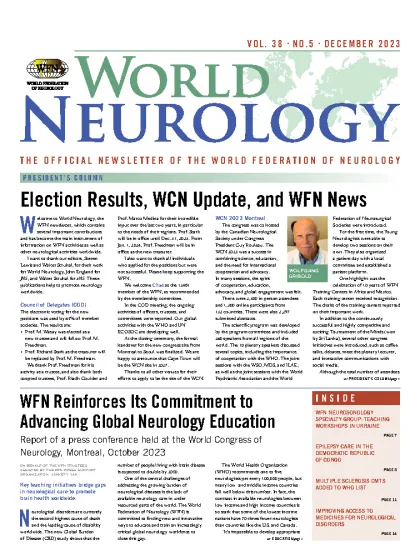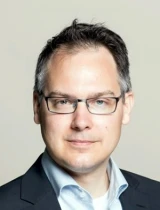Document download: World Neurology - December 2023

Description:
World Neurology: December 2023, Volume 38, No. 5
Release date: 16 Dec 2023
Published: 20 Aug 2025
Filename:
wn_dec23.pdf
File type and size:
pdf, 2.71 MB
View/download:
Published by Ascend Integrated Media LLC, Kansas, USA
From the editors
Steven L. Lewis, MD, Editor, and Walter Struhal, MD, Co-Editor



We'd like to welcome all readers to the December issue of World Neurology, the last issue of 2023.
The issue begins with the President's Column, where WFN President Dr. Grisold provides an overview and recap of the many activities of the World Congress of Neurology (WCN), which recently occurred in Montreal, including the Council of Delegates meeting. Dr. Grisold also updates us on other ongoing initiatives and global activities of the WFN. In an accompanying article, the many WFN activities that were highlighted at the WCN press conference are summarized. Later in the issue, a photo montage from the WCN shows a sampling of the activities from this remarkable and highly attended event.
Three articles in this issue discuss essential medicines for neurological disorders (issues that the WFN is highly involved in), including a global overview of this important issue by Drs P. Brhlikova, R. Walker, N. Fothergill–Misbah, and AM Pollock, a report by Dr. Grisold and Dr. Pochigaeva on the World Health Organization (WHO) meeting on improving access to neurological medicines, and an update on the recently approved disease-modifying therapies (DMTs) for multiple sclerosis (MS) on the WHO essential medicines list, by Drs. B. Yamout, T. Kalincik, J. Laurson-Doube, B. Hemmer, and S. Viswanatha.
In another article, Dr. Prince Kazadi, Director of Aslek Epilepsy in the Democratic Republic of Congo (DRC) along with his collaborators, Drs. M. Lubendo, D. Tshiyuk, and N. Kimponto, discuss the activities of their organization with regard to research, staff training, community education, and patient care for patients with epilepsy.
In this month's history column, Dr. Peter J. Koehler describes the history and theories of speculations about the relation between the function of the brain and its movements. In a second historically based article in the issue, Drs. Domenico Inzitari and Vladimir Hachinski provide their analysis of the possible role of Tourette's syndrome in a famous figure in Spanish history.
Several regional meetings are also reported in this issue, including the report by Dr. Alex Razumovsky from the WFN's Neurosonology Specialty Group and his colleagues Dr. K. Potapova, L. Sokolova, D. Andreichenko, and S. Dudukina, who report on workshops in Ukraine that discussed clinical use of transcranial Doppler ultrasonography for patients with various disorders, including its application for wartime traumatic brain injury. Drs. Amir Molaie and David Liebeskind report on the 2023 International Symposium on Thrombolysis/Thrombectomy and Acute Stroke Therapy and the Symposium on Collaterals on the Brain that occurred at the University of California, Los Angeles, and was attended by global experts.
Drs. Satish Khadilkar and Gagandeep Singh announce the recent publication of the second edition of the Indian Academy of Neurology (IAN) Textbook of Neurology, a highly comprehensive and up-to-date two-volume textbook relevant to neurologists worldwide.
Finally, this issue features a heartfelt obituary for Prof. Hany Aref, a remarkable neurologic leader and a wonderful man. Although he is so greatly missed by those many of us who were fortunate enough to know him and to learn from him, his legacy as a leader in neurology and in stroke care in Egypt and worldwide will be long-lasting.
In closing, in this last issue of 2023, we want to wish everyone a wonderful new year and look forward to sharing additional information with you about the WFN and neurology and neurologists around the world in our future issues of World Neurology. ■
Highlights
President's Column
-
WCN Update, Election Results, and WFN News ⧉
By Wolfgang GrisoldWelcome to World Neurology, the WFN newsletter, which contains several important contributions and has become the main instrument of information on WFN activities as well as other neurological activities worldwide. I want to thank our editors, Steven Lewis and Walter Struhal, for their work for World Neurology, John England for JNS, and Walter Struhal for eNS. These publications help to promote neurology worldwide.
- Improving Access to Medicines for Neurological Disorders ⧉
By Ksenia Pochigaeva and Wolfgang GrisoldThis two-day meeting in Geneva, Switzerland, was composed of worldwide high-level representatives looking at essential medicines for neurological disorders. It was organized through collaboration of several WHO departments, including the Brain Health Unit, the Medicines and Health Products Division and the Non-Communicable Diseases Department, as well as representatives of several WHO regional and country offices.
The WFN Committees and Specialty Groups
- WFN Neurosonology Specialty Group: Teaching Workshops ⧉
By Kateryna Potapova, Larisa Sokolova, Dmitro Andreichenko, Svetlana Dudukina, and Alex RazumovskyThe Neurosonology Specialty Group (NSG) of the WFN is dedicated to the promotion of science and research as well of education and training in the field of ultrasonic techniques and its clinical utilization. Therefore, international cooperation and the dissemination of scientific information within the field of neurosonology is part of the NSG activities.
From WFN
- WFN Reinforces Its Commitment to Advancing Global Neurology Education ⧉
On behalf of the WFN trustees, assisted by the WFN press support organization, Yakkety YakA press conference at the World Congress of Neurology reported on WFN Training Centers, global partnerships, WHO's Intersectoral Global Action Plan, and the global impact of the WCN.
Around the World
- IAN Textbook of Neurology ⧉
By Satish V. Khadilkar and Gagandeep SinghThe "IAN Textbook of Neurology," edited by Satish V. Khadilkar and Gagandeep Singh, is a comprehensive two-volume sourcebook for students and postgraduates in neurology and practicing neurologists. The book has been compiled by an experienced team of authors from various parts of India and international contributors, and is structured into various sections, including history and examination methods, neuroanatomy and neurophysiology, the clinical and diagnostic approaches to various nervous system diseases, and therapeutic aspects.
- Epilepsy Care in the Democratic Republic of Congo ⧉
By Dr. Prince Kazadi, Dr. Moise Lubendo, Dr. Daniel Tshiyuk, and Dr. Nazaire KimpontoThe ASLEK Epilepsy Association in the Democratic Republic of Congo (DRC) is the unique national non-profit organization in the DRC, working in the field of research, staff training, community education, and patient care in neurology in general and epileptology specifically since 2008.
- Multiple Sclerosis DMTs Added to WHO List ⧉
By Bassem Yamout, Tomas Kalincik2, Joanna Laurson-Doube, Bernhard Hemmer, Shanthi ViswanathanOn July 26, 2023, the World Health Organization (WHO) added three disease-modifying therapies (DMTs) for multiple sclerosis (MS) to its Essential Medicines List (EML) for the first time. The list is an important tool for achieving universal health coverage, providing guidance to governments, health facilities, and procurers on priority medicines to tackle important public health conditions.
- The 2023 International Symposium on Thrombolysis/Thrombectomy and Acute Stroke Therapy, and the Symposium on Collaterals on the Brain ⧉
By Amir Molaie and David LiebeskindIn the rapidly evolving field of stroke care, events that gather global experts to discuss recent trials and innovations are integral to disseminating knowledge and advancing care. Building on the momentum of the 15th World Stroke Congress, the 2023 International Symposium on Thrombolysis/Thrombectomy and Acute Stroke Therapy (TTST) and the 10th annual Symposium on Collaterals on the Brain (Collaterals), proved no exception.
- Bridging the Treatment Gap ⧉
By Brhlikova, P., Walker, R., Fothergill–Misbah, N., Pollock, AM.The Intersectoral Global Action Plan on Epilepsy and other Neurological Disorders (IGAP) 2022-2031 recognizes the gap in availability of essential medicines to treat neurological disorders and the need for health system strengthening to ensure access to them. Access to essential medicines is fundamental to the human right to health and is enshrined in the United Nations Sustainable Development Goals.
History
- History and the Tourette Syndrome: The Case of Conde Duque de Olivares ⧉
By Domenico Inzitari, MD, And Vladimir Hachinski, MD, DScEarly in the seventeenth century, France and Spain vied for predominance, led by Cardinal Richelieu (Armand Jean du Plessis de Richelieu,1585-1642) and the Conde Duque de Olivares (Gaspar de Guzmán y Pimentel, 1587-1645) respectively. Gregorio Marañon y Posadillo (1887-1960), founder of Spanish endocrinology, documented in a now classic biography manic depressive swings in the mood of Olivares. Temper and behavior disorders were also reported by other contemporary or modern biographists.
- The Study of Brain Movements ⧉
By Peter J. Koehler, MD, PhD, FAANNaturalists have thought about and done experiments with respect to brain movements at least since Galen of Pergamon (129-216 CE). They wondered about the relation between the function of the brain and its movements. These movements could be observed in cranial wounds, as was described in the Edwin Smith surgical papyrus almost three millennia BCE, but also in children while the fontanel was still open, which was probably already noted by Pliny (23-79 CE). Most neurologists will have observed the movements indirectly, when doing a lumbar puncture and measuring the pressure in a plastic tube. In this essay, I will provide some historical information about this subject.
In Memoriam
- Prof. Hany Mohammed Aref (1961-2023) ⧉
By Riadh Guider and Maged Abdel NaseerThe medical and neurology communities are deeply saddened by the passing of Prof. Hany Aref, on July 26, 2023, at the age of 62 years. He made an indelible impact on neurology and stroke at the national, regional, and international levels.







